Recent Seasonal Spatiotemporal Variations in Alpine Glacier Surface Elevation in the Pamir
Abstract
1. Introduction
2. Data and Methodology
2.1. Data
2.2. Point Cloud Denoising and Accuracy-Optimization Methods
2.3. Large-Scale Variations in Yearly Time-Series Reconstruction of Glacier Surface Elevation
2.4. Local Scale Variations in Seasonal Time-Series Reconstruction of Glacier Surface Elevation
3. Results
3.1. Yearly Datum DEMs and Their Evaluations
3.2. Surface Elevation Variations in Pamir Glaciers
4. Discussion
5. Conclusions
Author Contributions
Funding
Data Availability Statement
Acknowledgments
Conflicts of Interest
References
- Sakai, A.; Fujita, K. Contrasting glacier responses to recent climate change in high-mountain Asia. Sci. Rep. 2017, 7, 13719. [Google Scholar] [CrossRef] [PubMed]
- Miles, E.; McCarthy, M.; Dehecq, A.; Kneib, M.; Fugger, S.; Pellicciotti, F. Health and sustainability of glaciers in High Mountain Asia. Nat. Commun. 2021, 12, 2868. [Google Scholar] [CrossRef]
- Bhattacharya, A.; Bolch, T.; Mukherjee, K.; King, O.; Menounos, B.; Kapitsa, V.; Neckel, N.; Yang, W.; Yao, T. High Mountain Asian glacier response to climate revealed by multi-temporal satellite observations since the 1960s. Nat. Commun. 2021, 12, 4133. [Google Scholar] [CrossRef] [PubMed]
- Francis, J.A.; Skific, N.; Vavrus, S.J. Increased persistence of large-scale circulation regimes over Asia in the era of amplified Arctic warming, past and future. Sci. Rep. 2020, 10, 14953. [Google Scholar] [CrossRef]
- Marzeion, B.; Jarosch, A.H.; Gregory, J.M. Feedbacks and mechanisms affecting the global sensitivity of glaciers to climate change. Cryosphere 2014, 8, 59–71. [Google Scholar] [CrossRef]
- Yao, T.D.; Thompson, L.; Yang, W.; Yu, W.S.; Gao, Y.; Guo, X.J.; Yang, X.X.; Duan, K.Q.; Zhao, H.B.; Xu, B.Q.; et al. Different glacier status with atmospheric circulations in Tibetan Plateau and surroundings. Nat. Clim. Chang. 2012, 2, 663–667. [Google Scholar] [CrossRef]
- Brun, F.; Berthier, E.; Wagnon, P.; Kääb, A.; Treichler, D. A spatially resolved estimate of High Mountain Asia glacier mass balances from 2000 to 2016. Nat. Geosci. 2017, 10, 668–673. [Google Scholar] [CrossRef]
- Bolch, T.; Kulkarni, A.; Kääb, A.; Huggel, C.; Paul, F.; Cogley, J.G.; Frey, H.; Kargel, J.S.; Fujita, K.; Scheel, M.; et al. The State and Fate of Himalayan Glaciers. Science 2012, 336, 310–314. [Google Scholar] [CrossRef]
- Gardelle, J.; Berthier, E.; Arnaud, Y.; Kääb, A. Region-wide glacier mass balances over the Pamir-Karakoram-Himalaya during 1999–2011. Cryosphere 2013, 7, 1263–1286. [Google Scholar] [CrossRef]
- Kääb, A.; Treichler, D.; Nuth, C.; Berthier, E. Brief Communication: Contending estimates of 2003–2008 glacier mass balance over the Pamir–Karakoram–Himalaya. Cryosphere 2015, 9, 557–564. [Google Scholar] [CrossRef]
- Farinotti, D.; Immerzeel, W.W.; De Kok, R.J.; Quincey, D.J.; Dehecq, A. Manifestations and mechanisms of the Karakoram glacier Anomaly. Nat. Geosci. 2020, 13, 8–16. [Google Scholar] [CrossRef] [PubMed]
- Treichler, D.; Kääb, A.; Salzmann, N.; Xu, C.-Y. Recent glacier and lake changes in High Mountain Asia and their relation to precipitation changes. Cryosphere 2019, 13, 2977–3005. [Google Scholar] [CrossRef]
- Berthier, E.; Brun, F. Karakoram geodetic glacier mass balances between 2008 and 2016: Persistence of the anomaly and influence of a large rock avalanche on Siachen Glacier. J. Glaciol. 2019, 65, 494–507. [Google Scholar] [CrossRef]
- Bhambri, R.; Hewitt, K.; Kawishwar, P.; Pratap, B. Surge-type and surge-modified glaciers in the Karakoram. Sci. Rep. 2017, 7, 15391. [Google Scholar] [CrossRef] [PubMed]
- Komatsu, T.; Watanabe, T. Glacier-Related Hazards and Their Assessment in the Tajik Pamir: A Short Review. Geogr. Stud. 2014, 88, 117–131. [Google Scholar] [CrossRef]
- Ren, J.; Jing, Z.; Pu, J.; Qin, X. Glacier variations and climate change in the central Himalaya over the past few decades. Ann. Glaciol. 2006, 43, 218–222. [Google Scholar] [CrossRef]
- Lüthi, M.P. Transient response of idealized glaciers to climate variations. J. Glaciol. 2009, 55, 918–930. [Google Scholar] [CrossRef][Green Version]
- Farinotti, D.; Huss, M.; Fürst, J.J.; Landmann, J.M.; Machguth, H.; Maussion, F.; Pandit, A. A consensus estimate for the ice thickness distribution of all glaciers on Earth. Nat. Geosci. 2019, 12, 168–173. [Google Scholar] [CrossRef]
- Huss, M. Density assumptions for converting geodetic glacier volume change to mass change. Cryosphere 2013, 7, 877–887. [Google Scholar] [CrossRef]
- Mayr, E.; Hagg, W. Debris-Covered Glaciers. In Geomorphology of Proglacial Systems: Landform and Sediment Dynamics in Recently Deglaciated Alpine Landscapes; Heckmann, T., Morche, D., Eds.; Springer International Publishing: Cham, Switzerland, 2019; pp. 59–71. [Google Scholar]
- Farinotti, D.; Huss, M.; Bauder, A.; Funk, M.; Truffer, M. A method to estimate the ice volume and ice-thickness distribution of alpine glaciers. J. Glaciol. 2009, 55, 422–430. [Google Scholar] [CrossRef]
- Thibert, E.; Blanc, R.; Vincent, C.; Eckert, N. Glaciological and volumetric mass-balance measurements: Error analysis over 51 years for Glacier de Sarennes, French Alps. J. Glaciol. 2008, 54, 522–532. [Google Scholar] [CrossRef]
- Uuemaa, E.; Ahi, S.; Montibeller, B.; Muru, M.; Kmoch, A. Vertical Accuracy of Freely Available Global Digital Elevation Models (ASTER, AW3D30, MERIT, TanDEM-X, SRTM, and NASADEM). Remote Sens. 2020, 12, 3482. [Google Scholar] [CrossRef]
- Zhang, Z.; Tao, P.; Liu, S.; Zhang, S.; Huang, D.; Hu, K.; Lu, Y. What controls the surging of Karayaylak glacier in eastern Pamir? New insights from remote sensing data. J. Hydrol. 2022, 607, 127577. [Google Scholar] [CrossRef]
- Du, W.; Shi, N.; Xu, L.; Zhang, S.; Ma, D.; Wang, S. Monitoring the Spatiotemporal Difference in Glacier Elevation on Bogda Mountain from 2000 to 2017. Int. J. Environ. Res. Public Health 2021, 18, 6374. [Google Scholar] [CrossRef] [PubMed]
- Du, W.; Ji, W.; Xu, L.; Wang, S. Deformation Time Series and Driving-Force Analysis of Glaciers in the Eastern Tienshan Mountains Using the SBAS InSAR Method. Int. J. Environ. Res. Public Health 2020, 17, 2836. [Google Scholar] [CrossRef] [PubMed]
- Morris, A.; Moholdt, G.; Gray, L. Spread of Svalbard Glacier Mass Loss to Barents Sea Margins Revealed by CryoSat-2. J. Geophys. Res. Earth Surf. 2020, 125, e2019JF005357. [Google Scholar] [CrossRef]
- Trantow, T.; Herzfeld, U.C.; Helm, V.; Nilsson, J. Sensitivity of glacier elevation analysis and numerical modeling to CryoSat-2 SIRAL retracking techniques. Comput. Geosci. 2021, 146, 104610. [Google Scholar] [CrossRef]
- Lin, H.; Li, G.; Cuo, L.; Hooper, A.; Ye, Q. A decreasing glacier mass balance gradient from the edge of the Upper Tarim Basin to the Karakoram during 2000–2014. Sci. Rep. 2017, 7, 6712. [Google Scholar] [CrossRef] [PubMed]
- Lv, M.; Quincey, D.J.; Guo, H.; King, O.; Liu, G.; Yan, S.; Lu, X.; Ruan, Z. Examining geodetic glacier mass balance in the eastern Pamir transition zone. J. Glaciol. 2020, 66, 927–937. [Google Scholar] [CrossRef]
- Haritashya, U.K.; Bishop, M.P.; Shroder, J.F.; Bush, A.B.G.; Bulley, H.N.N. Space-based assessment of glacier fluctuations in the Wakhan Pamir, Afghanistan. Clim. Chang. 2009, 94, 5–18. [Google Scholar] [CrossRef]
- Zhang, Z.; Xu, J.-L.; Liu, S.-Y.; Guo, W.-Q.; Wei, J.-F.; Feng, T. Glacier changes since the early 1960s, eastern Pamir, China. J. Mt. Sci. 2016, 13, 276–291. [Google Scholar] [CrossRef]
- Shangguan, D.; Liu, S.; Ding, Y.; Guo, W.; Xu, B.; Xu, J.; Jiang, Z. Characterizing the May 2015 Karayaylak Glacier surge in the eastern Pamir Plateau using remote sensing. J. Glaciol. 2016, 62, 944–953. [Google Scholar] [CrossRef]
- Snethlage, M.A.; Geschke, J.; Ranipeta, A.; Jetz, W.; Yoccoz, N.G.; Körner, C.; Spehn, E.M.; Fischer, M.; Urbach, D. A hierarchical inventory of the world’s mountains for global comparative mountain science. Sci. Data 2022, 9, 149. [Google Scholar] [CrossRef]
- Aizen, V.B.; Mayewski, P.A.; Aizen, E.M.; Joswiak, D.R.; Surazakov, A.B.; Kaspari, S.; Grigholm, B.; Krachler, M.; Handley, M.; Finaev, A. Stable-isotope and trace element time series from Fedchenko glacier (Pamirs) snow/firn cores. J. Glaciol. 2009, 55, 275–291. [Google Scholar] [CrossRef]
- Immerzeel, W.W.; Wanders, N.; Lutz, A.F.; Shea, J.M.; Bierkens, M.F.P. Reconciling high-altitude precipitation in the upper Indus basin with glacier mass balances and runoff. Hydrol. Earth Syst. Sci. 2015, 19, 4673–4687. [Google Scholar] [CrossRef]
- Goerlich, F.; Bolch, T.; Paul, F. Inventory of surging glaciers in the Pamir. Pangaea 2020. [Google Scholar] [CrossRef]
- Lv, M.; Guo, H.; Lu, X.; Liu, G.; Yan, S.; Ruan, Z.; Ding, Y.; Quincey, D.J. Characterizing the behaviour of surge- and non-surge-type glaciers in the Kingata Mountains, eastern Pamir, from 1999 to 2016. Cryosphere 2019, 13, 219–236. [Google Scholar] [CrossRef]
- Brunt, K.M.; Neumann, T.A.; Smith, B.E. Assessment of ICESat-2 Ice Sheet Surface Heights, Based on Comparisons Over the Interior of the Antarctic Ice Sheet. Geophys. Res. Lett. 2019, 46, 13072–13078. [Google Scholar] [CrossRef]
- Zhang, Y.; Pang, Y.; Cui, D.; Ma, Y.; Chen, L. Accuracy Assessment of the ICESat-2/ATL06 Product in the Qilian Mountains Based on CORS and UAV Data. IEEE J. Sel. Top. Appl. Earth Obs. Remote Sens. 2020, 14, 1558–1571. [Google Scholar] [CrossRef]
- Li, R.; Li, H.; Hao, T.; Qiao, G.; Cui, H.; He, Y.; Hai, G.; Xie, H.; Cheng, Y.; Li, B. Assessment of ICESat-2 ice surface elevations over the Chinese Antarctic Research Expedition (CHINARE) route, East Antarctica, based on coordinated multi-sensor observations. Cryosphere 2021, 15, 3083–3099. [Google Scholar] [CrossRef]
- Brunt, K.M.; Smith, B.E.; Sutterley, T.C.; Kurtz, N.T.; Neumann, T.A. Comparisons of Satellite and Airborne Altimetry with Ground-Based Data From the Interior of the Antarctic Ice Sheet. Geophys. Res. Lett. 2021, 48, e2020GL090572. [Google Scholar] [CrossRef]
- Chen, W.; Yao, T.; Zhang, G.; Li, F.; Zheng, G.; Zhou, Y.; Xu, F. Towards ice-thickness inversion: An evaluation of global digital elevation models (DEMs) in the glacierized Tibetan Plateau. Cryosphere 2022, 16, 197–218. [Google Scholar] [CrossRef]
- Gardner, A.S.; Moholdt, G.; Cogley, J.G.; Wouters, B.; Arendt, A.A.; Wahr, J.; Berthier, E.; Hock, R.; Pfeffer, W.T.; Kaser, G.; et al. A Reconciled Estimate of Glacier Contributions to Sea Level Rise: 2003 to 2009. Science 2013, 340, 852–857. [Google Scholar] [CrossRef] [PubMed]
- Moholdt, G.; Nuth, C.; Hagen, J.O.; Kohler, J. Recent elevation changes of Svalbard glaciers derived from ICESat laser altimetry. Remote Sens. Environ. 2010, 114, 2756–2767. [Google Scholar] [CrossRef]
- Wang, Q.; Yi, S.; Sun, W. Continuous Estimates of Glacier Mass Balance in High Mountain Asia Based on ICESat-1,2 and GRACE/GRACE Follow-On Data. Geophys. Res. Lett. 2021, 48, e2020GL090954. [Google Scholar] [CrossRef]
- Kääb, A.; Berthier, E.; Nuth, C.; Gardelle, J.; Arnaud, Y. Contrasting patterns of early twenty-first-century glacier mass change in the Himalayas. Nature 2012, 488, 495–498. [Google Scholar] [CrossRef]
- Hewitt, K. The Karakoram Anomaly? Glacier Expansion and the ‘Elevation Effect,’ Karakoram Himalaya. Mt. Res. Dev. 2009, 25, 332–340. [Google Scholar] [CrossRef]
- Gardelle, J.; Berthier, E.; Arnaud, Y. Slight mass gain of Karakoram glaciers in the early twenty-first century. Nat. Geosci. 2012, 5, 322–325. [Google Scholar] [CrossRef]
- Neckel, N.; Kropáček, J.; Bolch, T.; Hochschild, V. Glacier mass changes on the Tibetan Plateau 2003–2009 derived from ICESat laser altimetry measurements. Environ. Res. Lett. 2014, 9, 014009. [Google Scholar] [CrossRef]
- Kotlyakov, V.; Osipova, G.; Tsvetkov, D. Monitoring surging glaciers of the Pamirs, central Asia, from space. Ann. Glaciol. 2008, 48, 125–134. [Google Scholar] [CrossRef]
- Kapnick, S.B.; Delworth, T.L.; Ashfaq, M.; Malyshev, S.; Milly, P.C.D. Snowfall less sensitive to warming in Karakoram than in Himalayas due to a unique seasonal cycle. Nat. Geosci. 2014, 7, 834–840. [Google Scholar] [CrossRef]
- Wang, Q.; Yi, S.; Sun, W. Precipitation-driven glacier changes in the Pamir and Hindu Kush mountains. Geophys. Res. Lett. 2017, 44, 2817–2824. [Google Scholar] [CrossRef]
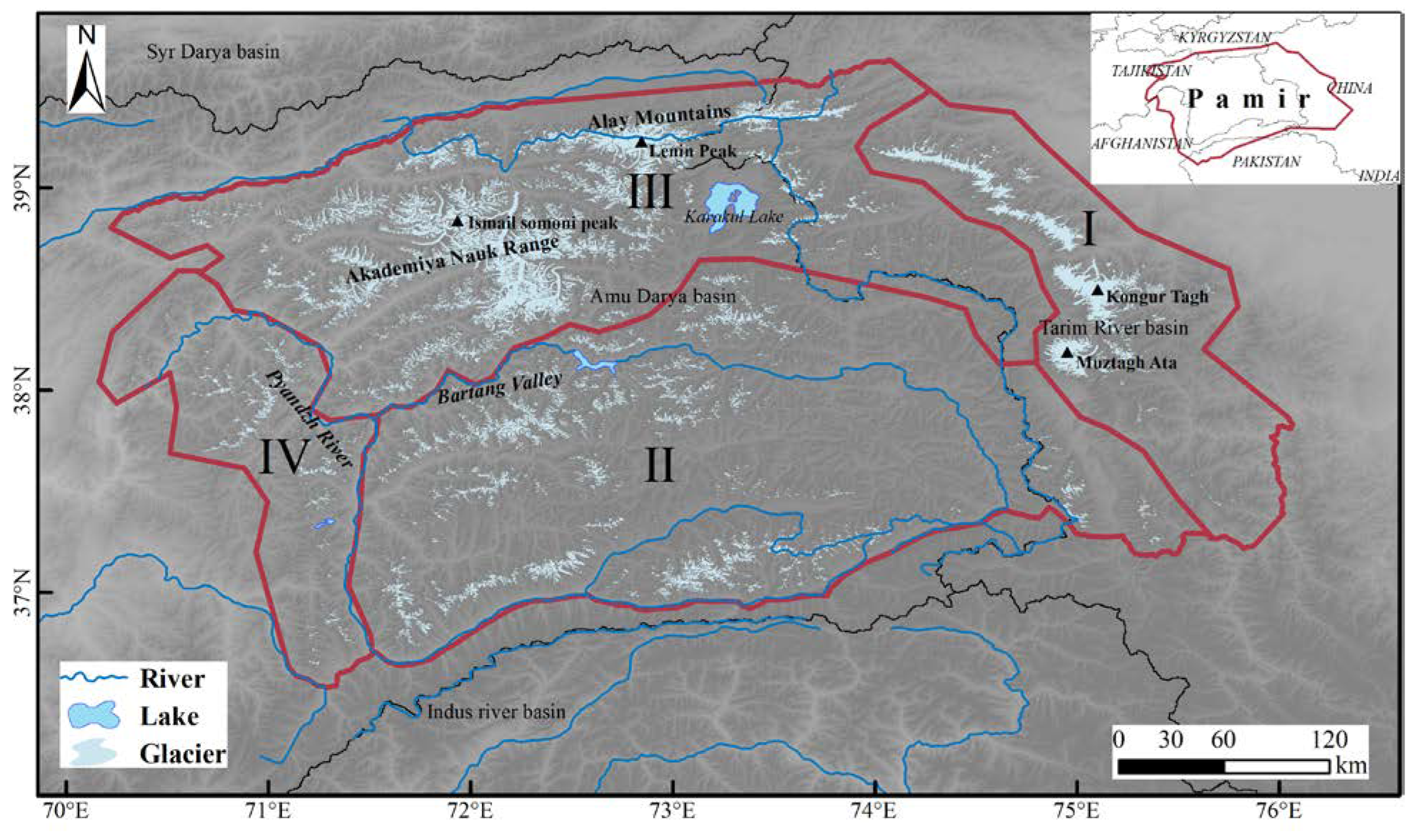
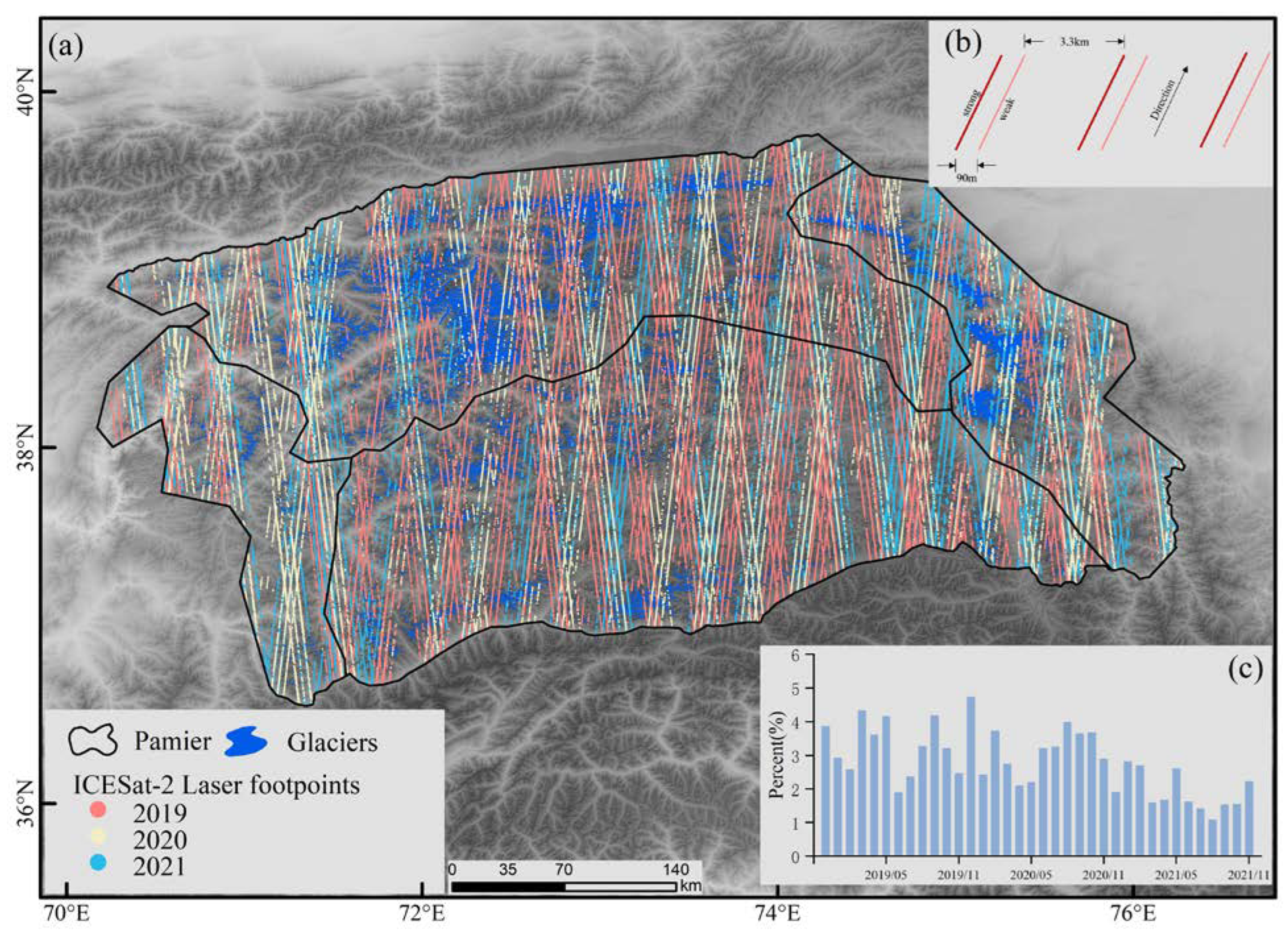


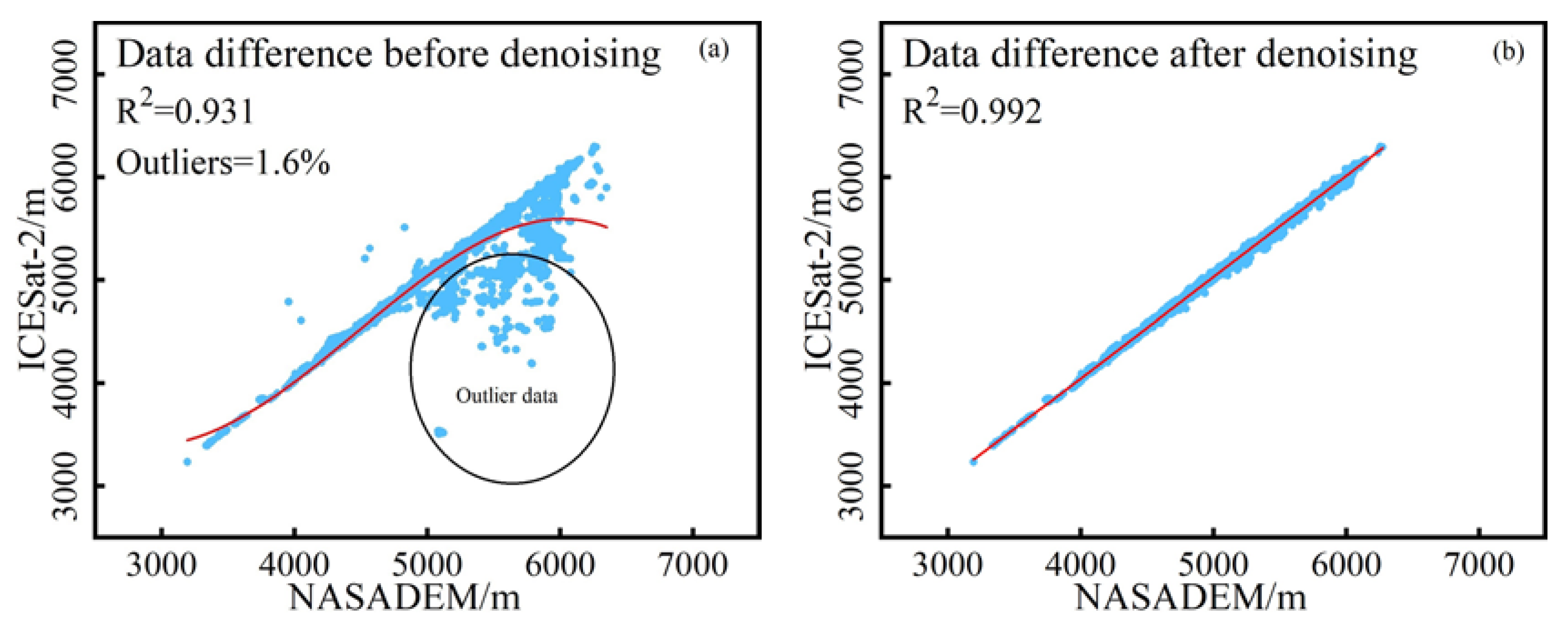
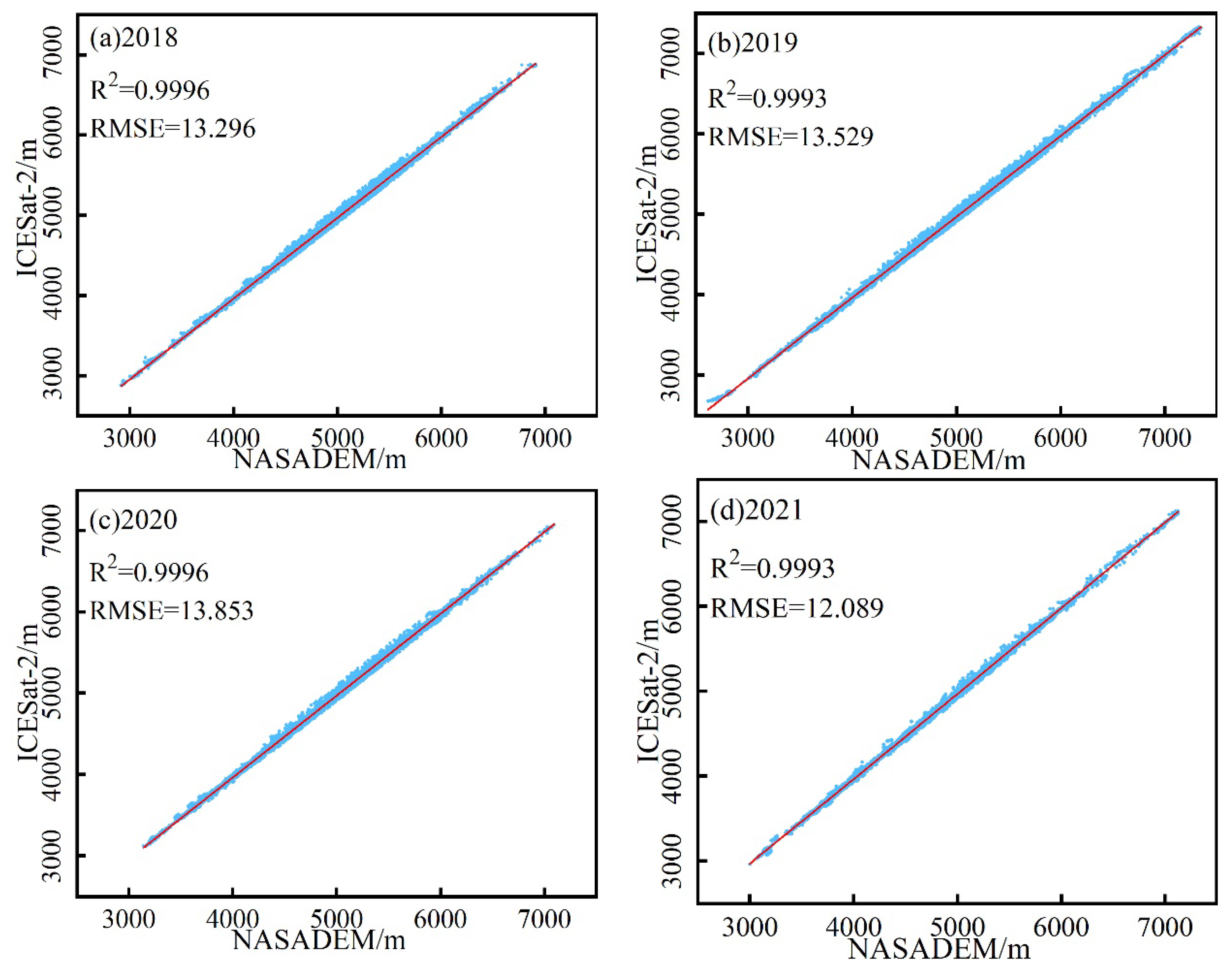
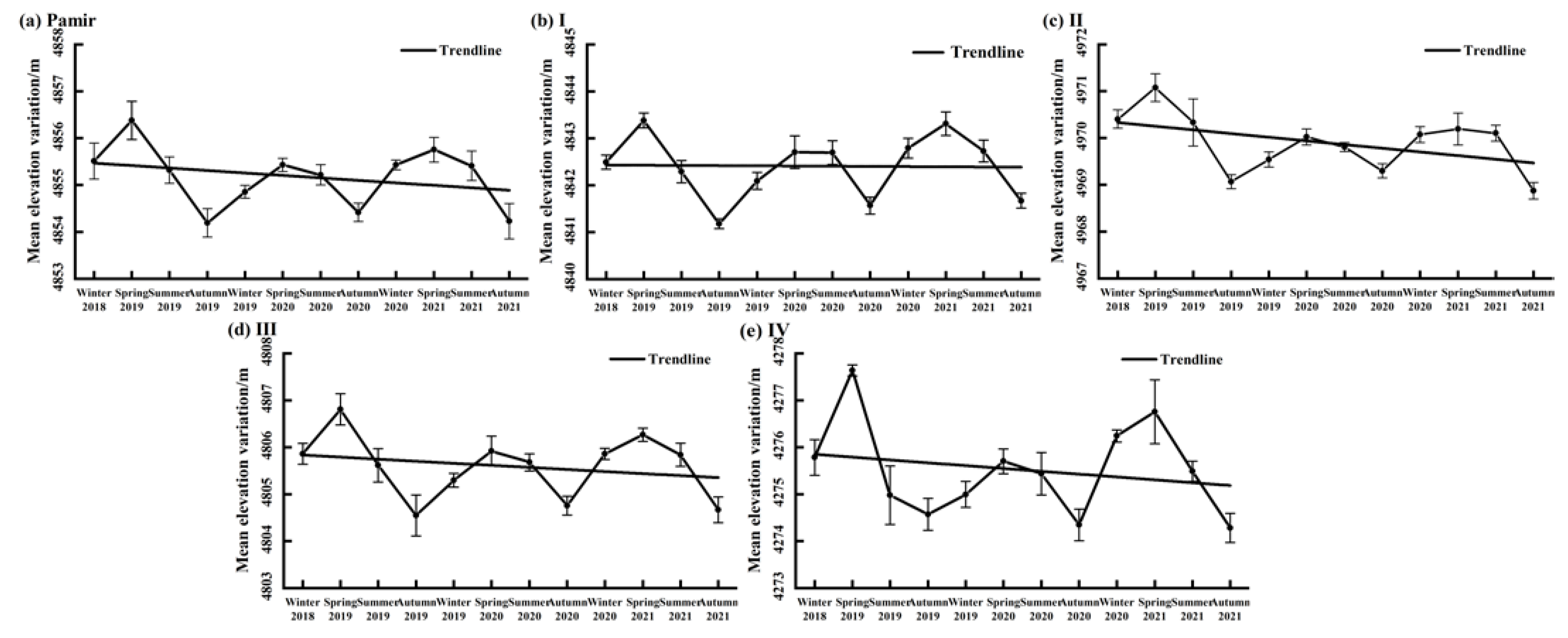

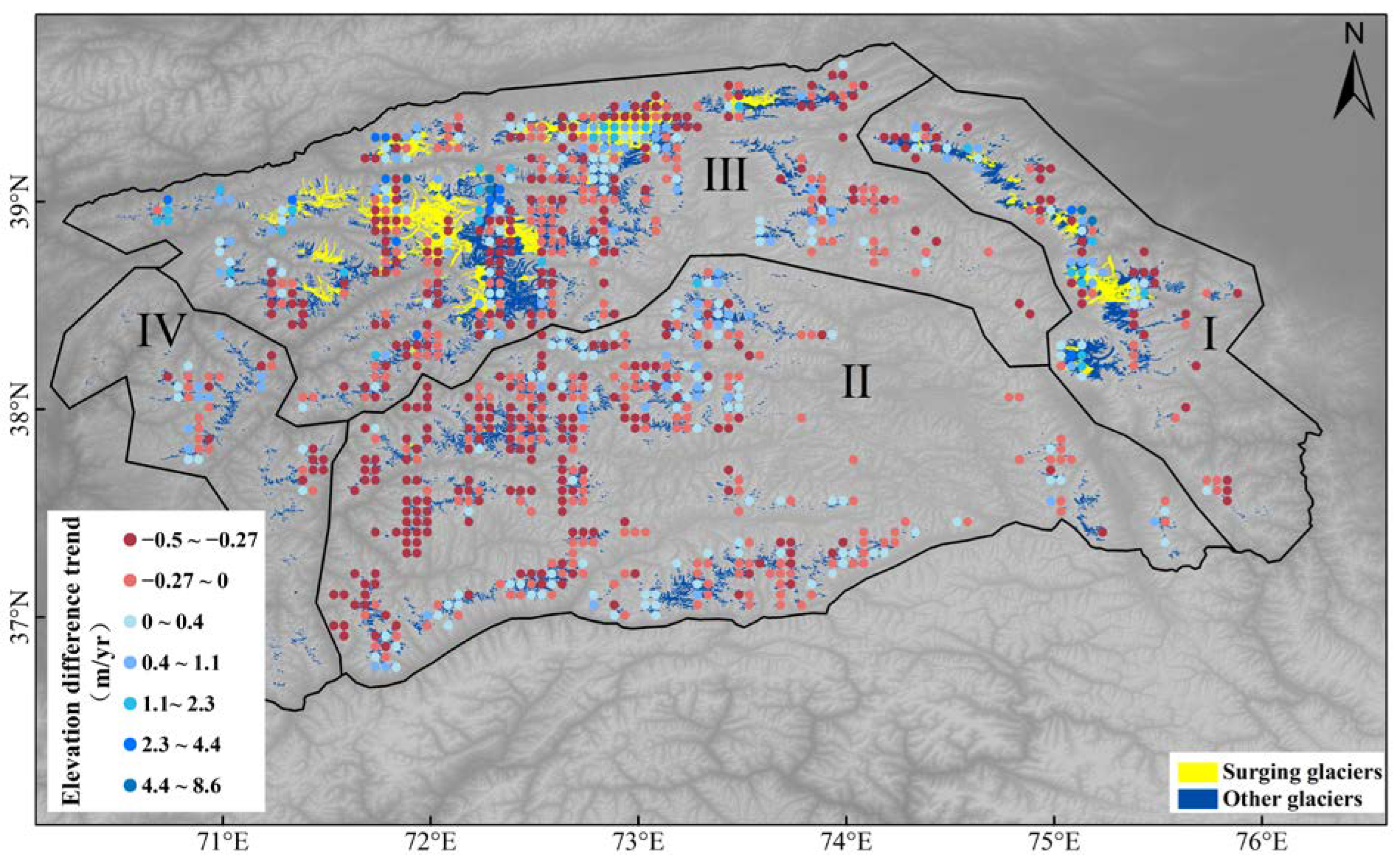
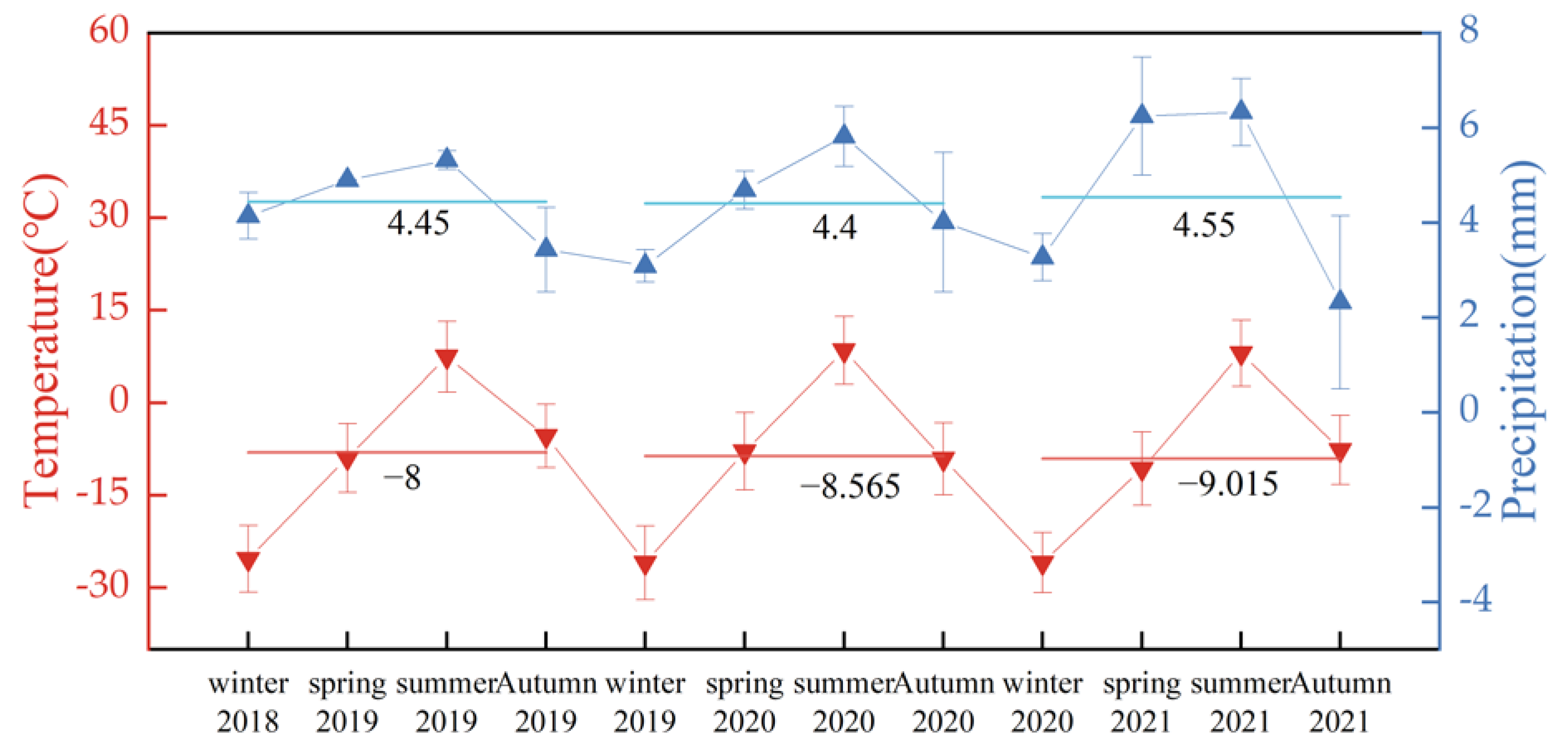

| Zone I | Zone II | Zone III | Zone IV | Pamir | ||
|---|---|---|---|---|---|---|
| 2018 winter–2020 | Winter | −0.4 ± 0.15 | −0.86 ± 0.53 | −0.56 ± 0.47 | −0.79 ± 0.57 | −0.66 ± 0.36 |
| Spring | −0.68 ± 0.37 | −1.05 ± 0.15 | −0.89 ± 0.15 | −1.93 ± 0.77 | −0.95 ± 0.81 | |
| Summer | 0.41 ± 0.15 | −0.53 ± 0.48 | 0.07 ± 0.02 | 0.46 ± 0.17 | −0.1 ± 0.04 | |
| Autumn | 0.39 ± 0.14 | 0.23 ± 0.18 | 0.21 ± 0.15 | −0.22 ± 0.08 | 0.22 ± 0.14 | |
| Yearly | −0.07 ± 0.05 | −0.55 ± 0.12 | −0.29 ± 0.18 | −0.62 ± 0.19 | −0.37 ± 0.12 | |
| 2020–2021 | Winter | 0.7 ± 0.27 | 0.53 ± 0.5 | 0.56 ± 0.12 | 1.25 ± 0.33 | 0.58 ± 0.96 |
| Spring | 0.61 ± 0.28 | 0.17 ± 0.09 | 0.35 ± 0.16 | 1.05 ± 0.21 | 0.32 ± 0.13 | |
| Summer | 0.15 ± 0.1 | 0.3 ± 0.12 | 0.16 ± 0.03 | 0.05 ± 0.02 | 0.19 ± 0.07 | |
| Autumn | 0.03 ± 0.01 | −0.42 ± 0.19 | −0.09 ± 0.04 | −0.07 ± 0.03 | −0.19 ± 0.07 | |
| Yearly | 0.36 ± 0.19 | 0.14 ± 0.05 | 0.24 ± 0.14 | 0.57 ± 0.13 | 0.23 ± 0.11 |
| Average Elevation for July, August, and September 2019 (m) | Average Elevation for July, August, and September 2020 (m) | Average Elevation for July, August, and September 2021 (m) | Elevation Variation (m/Year) | |
|---|---|---|---|---|
| Zone I | 4841.177 | 4841.568 | 4841.668 | +0.25 ± 0.13 |
| Zone II | 4969.066 | 4969.299 | 4968.875 | −0.096 ± 0.04 |
| Zone III | 4804.549 | 4804.758 | 4804.668 | +0.06 ± 0.04 |
| Zone IV | 4274.569 | 4274.347 | 4274.281 | −0.14 ± 0.08 |
| Pamir | 4854.194 | 4854.418 | 4854.229 | +0.02 ± 0.01 |
| Zone I | Zone II | Zone III | Zone IV | Pamir | |
|---|---|---|---|---|---|
| Precipitation (mm/year) | −0.55 ± 0.07 | +0.71 ± 0.12 | +0.99 ± 0.32 | −0.88 ± 0.55 | +0.46 ± 0.29 |
| Temperature (°C/year) | −0.41 ± 0.13 | −0.61 ± 0.39 | −0.54 ± 0.25 | −0.51 ± 0.18 | −0.54 ± 0.36 |
| Gardner et al. (2013) [7] | Gardelle et al. (2013) [9] | Kääb et al. (2015) [10] | Brun et al. (2017) [7] | This Study | |
|---|---|---|---|---|---|
| Data Sources | ICESat-SRTM | ICEsat SPOT5-SRTM | ICESat | ASTER | ICESat-2 NASA DEM |
| Study period | 2003–2009 | 2003–2009 2008–2011 | 2003–2009 | 2000–2016 | 2018–2021 |
| GMB a | -- | +0.14 ± 0.14 | -- | −0.08 ± 0.07 | +0.017 ± 0.01 |
| GSE b | −0.13 ± 0.22 | +0.16 ± 0.15 | −0.48 ± 0.14 | -- | +0.02 ± 0.01 |
Publisher’s Note: MDPI stays neutral with regard to jurisdictional claims in published maps and institutional affiliations. |
© 2022 by the authors. Licensee MDPI, Basel, Switzerland. This article is an open access article distributed under the terms and conditions of the Creative Commons Attribution (CC BY) license (https://creativecommons.org/licenses/by/4.0/).
Share and Cite
Du, W.; Zheng, Y.; Li, Y.; Bao, A.; Li, J.; Ma, D.; Gao, X.; Pan, Y.; Wang, S. Recent Seasonal Spatiotemporal Variations in Alpine Glacier Surface Elevation in the Pamir. Remote Sens. 2022, 14, 4923. https://doi.org/10.3390/rs14194923
Du W, Zheng Y, Li Y, Bao A, Li J, Ma D, Gao X, Pan Y, Wang S. Recent Seasonal Spatiotemporal Variations in Alpine Glacier Surface Elevation in the Pamir. Remote Sensing. 2022; 14(19):4923. https://doi.org/10.3390/rs14194923
Chicago/Turabian StyleDu, Weibing, Yanchao Zheng, Yangyang Li, Anming Bao, Junli Li, Dandan Ma, Xin Gao, Yaming Pan, and Shuangting Wang. 2022. "Recent Seasonal Spatiotemporal Variations in Alpine Glacier Surface Elevation in the Pamir" Remote Sensing 14, no. 19: 4923. https://doi.org/10.3390/rs14194923
APA StyleDu, W., Zheng, Y., Li, Y., Bao, A., Li, J., Ma, D., Gao, X., Pan, Y., & Wang, S. (2022). Recent Seasonal Spatiotemporal Variations in Alpine Glacier Surface Elevation in the Pamir. Remote Sensing, 14(19), 4923. https://doi.org/10.3390/rs14194923







